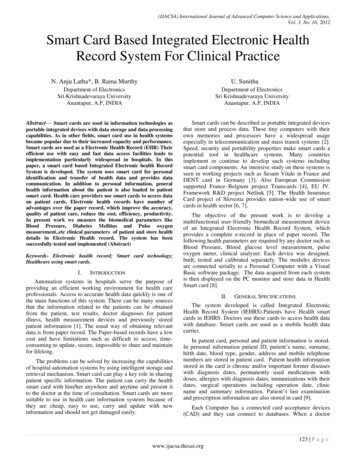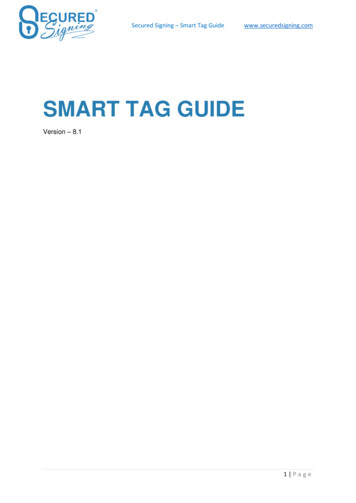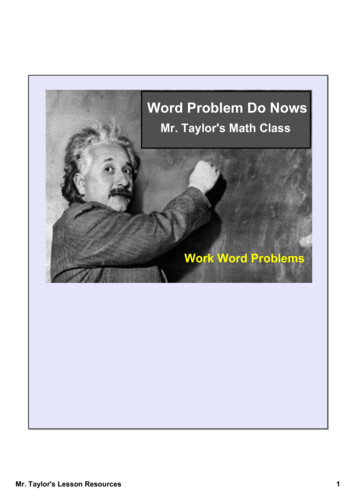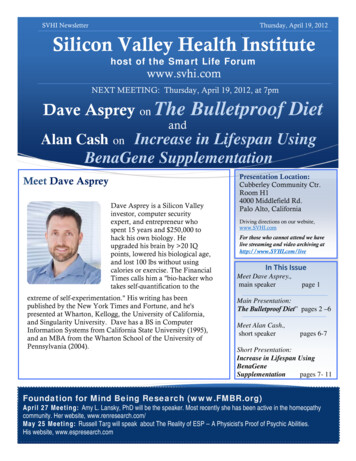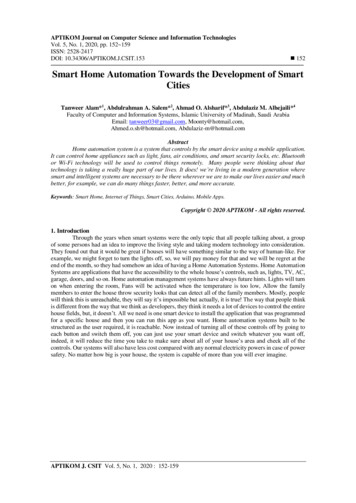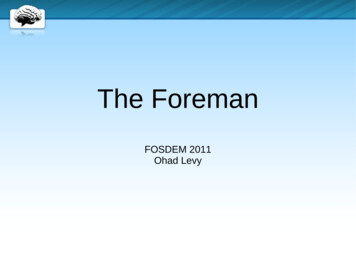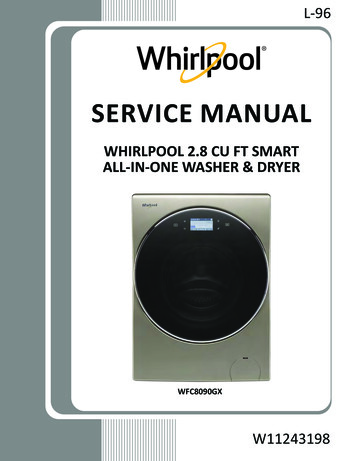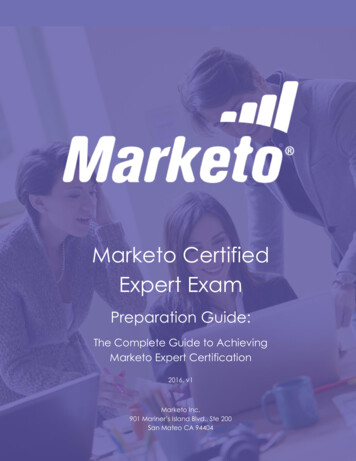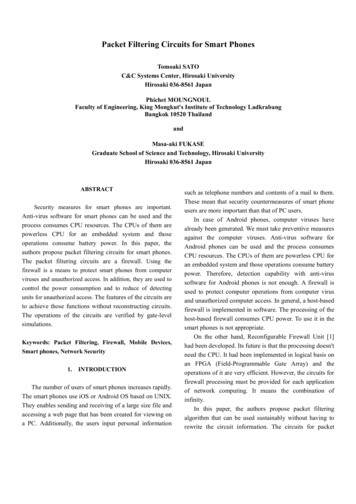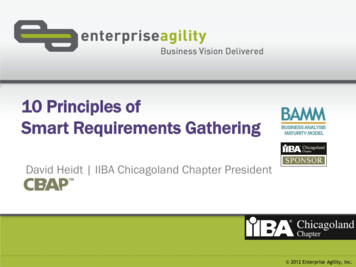
Transcription
10 Principles ofSmart Requirements GatheringDavid Heidt IIBA Chicagoland Chapter President 2012 Enterprise Agility, Inc.
Who/What is IIBAIIBA was formed in 2003 and is the independentnon-profit professional association serving thegrowing field of business analysis. 2012 Enterprise Agility, Inc.
VisionThe world's leading association forBusiness Analysis professionalsMissionDevelop and maintain standards for the practiceof business analysis and for the certification ofits practitioners 2012 Enterprise Agility, Inc.
IIBA Strategic Goals Creating and developing awareness and recognition of thevalue and contribution of the Business AnalystDefining the Business Analysis Body of Knowledge (BABOK )Providing a forum for knowledge sharing and contribution tothe business analysis professionPublicly recognizing and certifying qualified practitionersthrough an internationally acknowledged certificationprogram 2012 Enterprise Agility, Inc.
Facts and Figures Administrative office located in Toronto, Ontario, Canada.Launched in October 2003 with 23 founding members from twocountries.Developed and maintains the Business Analysis Body ofKnowledge (BABOK ) Guide which outlines the generally acceptedstandards and practices for this profession. Version 2 was published in2009.Members worldwide: over 18,000.Chapters: 89 in over 60 countries worldwide with 59 chapters inprogress.Certified Business Analysis Professionals (CBAP ) worldwide: 1000 . 2012 Enterprise Agility, Inc.
Business Analysis Body of Knowledge6 2012 Enterprise Agility, Inc.
IndustryAccreditedBusiness AnalystCertification While many professions had professionaldesignations, Business Analysts did not.Many education providers offer “certificate”programs to their students, but these are notprofessional “certifications”.IIBA decided that Business Analysis Professionalsneeded a certification program to ensure their skillswould be recognized, valued, and understood.IIBA awards certification designations to candidates who havesuccessfully demonstrated their expertise in the business analysisfield.This includes hands-on work experience and passing an exam for oneof the two certifications. 2012 Enterprise Agility, Inc.
Two IIBA CertificationsCertified Business Analysis ProfessionalCertification of Competency in Business AnalysisThe CCBA certification is for experiencedbusiness analysts who have acquired coreBA skills.CCBA recipients are recognized for theinvestment they have already made intheir business analysis careers.A CBAP recipient is an elite memberof the business analysis community.A recognized expert in identifying thebusiness needs of an organization inorder to determine business solutions.CBAP recipients are senior BAs whohave the skill and expertise to performbusiness analysis work on projects ofvarious sizes and complexities.These certification programs has been carefully designed to be in compliance withthe International Standards Organization (ISO) 17024 standard for certifying thecompetence of personnel. The program is also intended to achieve ISO approval. 2012 Enterprise Agility, Inc.
Requirements to apply for the CCBA and CBAP Minimum 3750 hours of BA workexperience aligned with the BABOK Guide in the last seven yearsMinimum 900 hours in two of the sixknowledge areas or 500 hours infour of the six knowledge areasMinimum 21 hours of ProfessionalDevelopment in the past four yearsMinimum high school education orequivalentTwo references from a careermanager, client or CBAP recipientSigned Code of Conduct Minimum 7500 hours of BA workexperience aligned with the BABOK Guidein the last 10 yearsMinimum 900 hours in four of the sixknowledge areasMinimum 21 hours of ProfessionalDevelopment in the past four yearsTwo references from a career manager,client or CBAP recipientSigned Code of ConductFor more information, refer to theCBAP and CCBA Handbooks in your suppliedreading material. 2012 Enterprise Agility, Inc.
Marketplace Drivers for BA Role Change Increasing number of complex, difficult tounderstand, legacy systems. Subject matter expertise (SME) attrition. Virtualization and outsourcing. Many BA training vendors. March towards establishing the BA as a professional(IIBA and ABPMP).New technology capabilities (i.e. BPMSs and BREs). 2012 Enterprise Agility, Inc.
The Elusive Business AnalystWhat’s the difference between aBusiness Analyst and UFO?People recognize a UFOwhen they see one 2012 Enterprise Agility, Inc.
Mixed IdentitiesSYSTEMS RANALYSTSUBJECT MATTEREXPERT1985SOFTWARESPECIALIST1990“A business what?”199512 2012 Enterprise Agility, Inc.
Early Influencers on the BA Role RDBs, Easy-to-Use ToolsC et al New development paradigm distractedprogrammers. Traditional 3G programmers (i.e. COBOL, PL-1)dropped out BAs.IT’s Value From Tools to Process AutomationThe rise of SDLCsThought leadership in new approaches todevelopment (UML, three amigos)EMERGINGBUSINESSANALYST13 2012 Enterprise Agility, Inc.
Common Issues with Business Analysis Issues with Partners/Collaborators: Issues within the BA practice as a whole: Different interfaces to the business side.Inconsistent artifacts.Variety of tools and techniques.Difficulty moving around resources.Hard to train new resources.Variations make oversight complex.Quality and Speed to Market Issues Defects found downstream in the lifecycleIncomplete and missing requirementsBurdens placed on roles downstream in the lifecycle 2012 Enterprise Agility, Inc.
Requirements are Too difficult and timeconsuming to createToo hard to useInadequateUnnecessaryEssential 2012 Enterprise Agility, Inc.
The Requirements Problem 2012 Enterprise Agility, Inc.
Traditional Approach Develop two lists: Things the system must do Constraints imposed by it or on it The traditional way of doing requirements is notwrong – it just doesn’t go far enough. 2012 Enterprise Agility, Inc.
Role of the Conventional Business OPERInterpretationInterpretationBAActs a interpreter that facilitatesIT building a business solutionARCHITECTSA 2012 Enterprise Agility, Inc.
Where do they go?Pull OrderHold OrderPack OrderShip Order CreditApprovedOrderCancelledPROCEDURE DIVISION.CREATE-REORDER-FILE.OPEN I-O STOCK-FILE.OPEN INPUT MANF-FILE.OPEN OUTPUT ORDER-FILE.READ STOCK-FILE NEXT RECORDAT END SET END-OF-FILE TO TRUE ENDREAD.PERFORM UNTIL END-OF-FILEIF (QTY-IN-STOCK-FB NOTGREATERTHAN REORDER-LEVELFB) AND (NOT-ONORDER)PERFORM CREATE-REORDERRECORDPERFORM UPDATE-STOCKRECORDEND-IFREAD STOCK-FILE NEXT RECORDAT END SET END-OF-FILE TO TRUEEND-READEND-PERFORMRestockOrder 2012 Enterprise Agility, Inc.
Problem with the Status Quo Business creates requirements, then IT builds something that “satisfies”requirements, but Business can’t look at the solution that ITimplements and see if it is what theyspecified, so Business asks IT what the solution that ITbuilt actually does.KEY: Fundamentally, this age-old cycle isincompatible with business agility! 2012 Enterprise Agility, Inc.
Business/IT Divide: How we got here Two independent root causes: With IT, drift has occurred from:delivering silo applications and manual workto:delivering highly automated processes BAs are have been unable to specify detailedbusiness behavior that is void of technical details. 2012 Enterprise Agility, Inc.
Reality Check: This Costs Us!Rework CostLabor CostOpportunity Cost 2012 Enterprise Agility, Inc.
Completeness 2012 Enterprise Agility, Inc.
Requirements Validation – In Practice Good faith effort to read all the documentationUltimately there will be sign-off Best Case: they thoroughly understand and agreeWorst Case: they don’t have time to invest and are willingto take your word for it At the End of the Day: Sign-offhappens because projects can’tproceed until this happens. 2012 Enterprise Agility, Inc.
Role of the Conventional Business OPERInterpretationInterpretationBAActs a interpreter that facilitatesIT building a business solutionARCHITECTSA 2012 Enterprise Agility, Inc.
12345678910BA’s Evolving Role 2012 Enterprise Agility, Inc.
Evolving the BA’s RoleBUSINESS ANALYSISPRACTICEIT ORGANIZATIONBUSINESSSMEs / STAKEHOLDERSSOLUTIONBUSINESSANALYSTThe BA delivers requirementsthat have beenevolved into solution-specifications that is“conceptually LOPERIT is responsible for transformingthe conceptual solution into animplementation while preservingcorrespondence to the originalconcepts. 2012 Enterprise Agility, Inc.
Requirements vs. Solution Specification Our “Requirements” effort requires two outcomes: Requirements: Goals and Constraints. Solution Specification: A description of the actualbehavior that meets the goals and constraints. Traditional requirements often stop atrequirements or only hint at specification.Completeness requires both. 2012 Enterprise Agility, Inc.
Goals of Specification Specify the business behaviorof the proposed system orchanges to existing system.Two types of businessbehavior: Visible behavior that will beimplemented in a UserInterface.Behavior not visible to theimmediate user but critical forthe correct functioning of thesystem. 2012 Enterprise Agility, Inc.
Goals of Specification Technology agnostic Why? Technology choices are the province ofIT.Details of look and feel can be adistraction if considered too early inthe specification process.Detailed enough to be testable: Specification when fully detailed willdetermine most of the test cases.Implementation team will work fromthe same specification withoutinterpretation arguments. 2012 Enterprise Agility, Inc.
Bottom line:Validating the Business Analyst’s WorkUpfront Once a solution is described it can be validated.Two validation goals for solution: It meets the requirements. Judged “workable” by stakeholders and potential users. 2012 Enterprise Agility, Inc.
Following in the Footsteps of OthersBoeing PhotoMax Ortiz / The Detroit News;Toyota 2012 Enterprise Agility, Inc.
Approaches to Quality Design-centric Design quality into theprocess to avoid reworkInter-related artifactswith built-in crossvalidationLean and six sigma Agile Mostly at the technicallevel Pair Programming(primarily XP) Automated Testing Test Driven Development Continuous integration RefactoringThese aren’t mutually exclusive 2012 Enterprise Agility, Inc.
Business Specification’s Payback Reduced Rework IT time used to: extract business logic fromexisting implementations, translate businessspecifications into IT implementation Rework involved in fixing inconsistencies inbusiness requirementsIncreased Business Agility Allows business innovation to happen at thespeed that business experts canconceptualize those changes Empowers business 2012 Enterprise Agility, Inc.
Key Benefits of Evolving the BA Role Standard set of analytic elements Defined patterns for analysis Provides standardized skills for BAs promoting BAflexibility.Eliminates the need to “invent” approachesproviding process predictabilityOpens an opportunity for the BA role tocontribute more direct business value Helps draw attention to areas where improvementhave direct business value. 2012 Enterprise Agility, Inc.
BIG PICTURE OF A SOLUTION SPECIFICATIONThis is a conceptual exampleNot all relationships are shown. 2012 Enterprise Agility, Inc.
BUSINESS PROCESS DESIGNWORKFLOW OW DESIGNUSER EXPERIENCEBUSINESS RULE DESIGNCONTENT DESIGNCONFIGURATION DEFINITION 2012 Enterprise Agility, Inc.
Validating USINESS INFORMATIONUserFlowUSERFLOWUSER EXPERIENCESTRUCTUREUSAGE SCENARIOSUSER EXPERIENCEVISUALIZATIONS 2012 Enterprise Agility, Inc.
Use Cases vs. Usage ScenariosCOMPARISONUser FlowsSCOPEFOCUSUsage ScenarioASPECTGeneral.Specific.One business function.One example, or instance, ofhow a business functionworks.Contains a main pathCONTENT alternate and exceptionpaths.Shows only a single path.May span multiple user flowsMay be realized by multipleTRACINGto create a more end-to-endusage scenarios.flow. 2012 Enterprise Agility, Inc.
Usage Scenarios Captures the businessbehavior realized by theinteraction between anactor and the system for agiven set of circumstances. Scenario: Pickup a Vehicle CounterActors:Rental CustomerSteps:1. Follow Signs for “ExistingReservations”2. .User BehaviorsActions defined in the UXSystem Services 2012 Enterprise Agility, Inc.
Usage Scenario Modeled in UMLThe “Customer ServiceRep” actor, the sameone used in theuserflow.Same UI Items that areon the NavigationDiagram.Ad hoc work performedby the Actor not doneusing the systemBusiness ServiceControllers that performbusiness work on behalfof the Actor.User action invoked bythe Actor. This actionlives on the “MainMenu” UI Item screenand will navigate theActor to the“Reservations” UI Itemthrough an invokeaction.An invoked businessservice of a BusinessService, in this case“ValidateExistingCustomer”. 2012 Enterprise Agility, Inc.
Navigation Linking with Usage ScenariosSAMESCREEN,DIFFERENTPERSPECTIVETHIS ACTIONINVOKED HEREIS THE SAMEACTION HERE 2012 Enterprise Agility, Inc.
Value of Usage Scenarios Usage Scenarios illustrate the proposed solution. They give specific examples of how things should work.Stakeholders get a better picture of what they’re getting.IT gets a better understanding of what they need tobuild.Usage Scenarios easily map to test cases. Clarify traceability.Leads to improved testing and quality. 2012 Enterprise Agility, Inc.
BA BoK Futures Intersection with Business Architecture Requirements Types Project Archetypes Business Meta-model Concepts 2012 Enterprise Agility, Inc.
Stakeholder Requests 2012 Enterprise Agility, Inc.
Characteristics of a Quality RequirementHmm, am Iwell-formed?Let’s see,I I am! I am!I am quirementUnambiguousTraceableIF YOUR REQUIREMENTS CAN’T BRAG LIKE THIS,THEY NEED TO GO BACK TO THE DRAWING BOARD.Source: IEEE 2012 Enterprise Agility, Inc.
The Line Item Requirement Few organizations cansuccessfully managerequirements using LineItem Requirements. Too little contextToo many requirementsHard to validate 2012 Enterprise Agility, Inc.
Other Stakeholder RequestsFlows SRs may be expressed as: Sample scenariosUsage storiesProcess flowCUSTOMER RESERVATION PROCEDURE1. Upon reaching the Reservation Page, customerenters the dates of reservation and the pickuplocation.2. The system parses the pickup location and if it isunable to determine the location, displays theavailable rental locations list for the customer tochoose.3. Customer specifies the car class desired.4. Customer submits the reservation request.5. The system determines if a car of specified carclass is available for the requested dates at therequested OUT OF CAR CLASS INVENTORY SCENARIOWhen the rental agent cannot assign a vehiclewhose car class matches the customer’srequested car class, he or she must attemptto find a vehicle in the next car classhigher unless a car of the same car class canbe transferred from a neighboring rentallocation.If no car classes from a higher car class areavailable, agent should offer a lower carclass with a U-Rent inconvenience coupon.UNRESERVE A VEHICLE 2012 Enterprise Agility, Inc.
The Limitations of Stakeholder RequirementsWhat issues do you find whenyou start to work withStakeholder Requirements? 2012 Enterprise Agility, Inc.
Refactoring Involves analyzing Stakeholder Requests andexpressing them into one or more SolutionRequirements.A Solution Requirement is expressed in its simplestform. (Cannot be broken down further) and providesvalue when defining a solution.Focus: Restating the requirement in more precise termsRemoving extraneous verbiageBreaking a statement with multiple requirements into distinctrequirementsFinding and eliminating duplicates 2012 Enterprise Agility, Inc.
Solution Requirement Solution Requirements are: Singular targeted statements that directly relate to asome part of solution.Functional Solution Requirements are often referredto as tionRequirementSolutionRequirement 2012 Enterprise Agility, Inc.
Requirement Categorization DiscussionWhat is the value ofcategorizing a requirement? 2012 Enterprise Agility, Inc.
Tracing From Stakeholder iness quirementSystem InterfaceRequirementUsabilityRequirement 2012 Enterprise Agility, Inc.
Breaking out RequirementsSTAKEHOLDER REQUEST“Name During Rental”“Street During Rental”“City During Rental”“State During Rental”“ZIP During Rental”“Phone During Rental”(6) INFORMATIONREQUIREMENTS(1) MonolithicRequirement“Ability for agent to enter name,address and phone number whererenter is residing during rental.”“Ability for any user to view name,address and phone number whererenter is residing during rental.”(2) FUNCTIONAL REQUIREMENTS“Address of renter residing duringrental will be validated byUSPS Address Standardization”(9) Solution Requirements“System must keep track of the renterduring the rental period.”SYSTEM INTERFACE REQUIREMENT 2012 Enterprise Agility, Inc.
Requirements Types DefinedDeploymentRequirementBusiness uirementOrganizationalChangeRequirementSystem InterfaceRequirementUsabilityRequirement 2012 Enterprise Agility, Inc.
Refactoring: Analysis Ad Nauseam? We’ve discussed how to break down a StakeholderRequest into to more manageable and well-definedstatements.The number of requirements categories to makeuse of can vary by project.Don’t apply a great technique to a problemthat doesn’t need it. 2012 Enterprise Agility, Inc.
What’s the Value? 2012 Enterprise Agility, Inc.
Traceability Ability to link requirements: Back to Stakeholders' motivations and/or externalmandatesForward to corresponding design artifacts, code,and test cases that achieve these.Usually accomplished in the form of a matrix or tree createdfor the verification and validation of the project. 2012 Enterprise Agility, Inc.
Requirements and Traceability Why do we do it?Why is it important? What doesn’t it buy us? 2012 Enterprise Agility, Inc.
Requirements Traceability:The Primary ConnectionMap requirements ontonarrower statements that mapdirectly toD implementableO elements of theautomation solution.WNMap requirementsto the processesthat areimpacted.UP 2012 Enterprise Agility, Inc.
Refactoring RequirementsWhat are the pitfalls of doing toomuch traceability? 2012 Enterprise Agility, Inc.
Shifting the CurveBaselineEngineered s 2012 Enterprise Agility, Inc.
INCREASING BUSINESS ANALYSIS PROFICIENCY 2012 Enterprise Agility, Inc.
Thank You!Questions?More Information atwww.enterprise–agility.com 2012 Enterprise Agility, Inc.
Defining the Business Analysis Body of Knowledge . Developed and maintains the Business Analysis Body of Knowledge (BABOK ) Guide which outlines the generally accepted standards and practi


